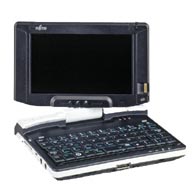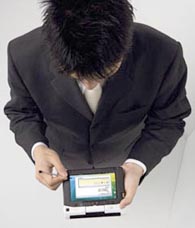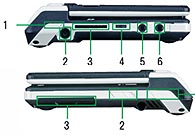Note 10/2007: We wrote the below description of the Lifebook U810 Mini-Notebook when it was first released in Japan as the Lifebook U8240 UMPC. For the US market, Fujitsu renamed it from UMPS to Mini-Notebook, and from U8240 to U810. The specs haven't changed much, and those listed in the spec bar to the right are those of the US model.
 Fujitsu has a long history of making some of the best pen tablet and slates, going all the way back to the dawn of pen computing in the early 1990s. More recently, Fujitsu has added a series of very competent Tablet PC convertible notebooks to its Lifebook line. And the company has also been offering miniature notebooks with touchscreens. They have frequently accompanied Pen Computing Magazine and RuggedPCReview.com staff on trips all over the globe. It is therefore no surprise that Fujitsu Japan has now launched an entirely new addition to its Lifebook lineup, the U Series of ultra-mobile PCs.
Fujitsu has a long history of making some of the best pen tablet and slates, going all the way back to the dawn of pen computing in the early 1990s. More recently, Fujitsu has added a series of very competent Tablet PC convertible notebooks to its Lifebook line. And the company has also been offering miniature notebooks with touchscreens. They have frequently accompanied Pen Computing Magazine and RuggedPCReview.com staff on trips all over the globe. It is therefore no surprise that Fujitsu Japan has now launched an entirely new addition to its Lifebook lineup, the U Series of ultra-mobile PCs.
However, the U Series is not your standard UMPC. Just like Acer introduced the Tabet PC convertible during the development process of the Micosoft-spec Tablet PC in 2001/2002, Fujitsu is offering a UMPC convertible instead of a little slate. In essence, the Lifebook U8240 is a micro PC that can also be used as a tablet in a way similar to how current Tablet PC convertible notebooks can be used either as standard notebooks or as tablets by rotating to display and folding it down flat onto the keyboard with the LCD facing up.
 The U Series models are small. Their 6.75 x 5.25 inch footprint is more like that of an early PDA than any sort of notebook computer. It's just an inch thick, though a battery bulge at the back adds another quarter of an inch or so. And the little machine weighs just 1.3 pounds, far less than any ultra-light notebook. Of course, you also get less computer than with a standard ultra-light. This is, after all, a convertible UMPC.
The U Series models are small. Their 6.75 x 5.25 inch footprint is more like that of an early PDA than any sort of notebook computer. It's just an inch thick, though a battery bulge at the back adds another quarter of an inch or so. And the little machine weighs just 1.3 pounds, far less than any ultra-light notebook. Of course, you also get less computer than with a standard ultra-light. This is, after all, a convertible UMPC.
The U Series' display measures just 5.6 inch diagonally and it uses a 1024 x 600 pixel format. That means a rather tiny screen but decent resolution. The picture below, from the Japanese website, shows how the U Series converts from a notebook to a slate.
 On the technology and specification side, things look pretty good. The U Series is powered by an 800MHz version of the Intel A110 processor, a chip designed specifically for the UMPC platform. It (and also the slower 600Mhz A100 version) use a 400MHZ frontside bus, have 512KB of Level 2 cache, are paired with the 945GU Express chipset, and are generally designed for energy-efficient operation.
On the technology and specification side, things look pretty good. The U Series is powered by an 800MHz version of the Intel A110 processor, a chip designed specifically for the UMPC platform. It (and also the slower 600Mhz A100 version) use a 400MHZ frontside bus, have 512KB of Level 2 cache, are paired with the 945GU Express chipset, and are generally designed for energy-efficient operation.
 The U8240 can be purchased either with Windows XP Professional or the Vista Business or Enterprise edition. There's just a single memory slot, occupied by either 512MB or a gig of DDR2 PC2-3200 SDRAM. Hard disks are of the Ultra ATA variety and range in size from 20 to 40 GB. In terms of connectivity, there is a single USB 2.0 port with a cover (1) , video-out, audio in/out in a 3.5mm jack, and a RJ45 LAN jack for the 10/100 Ethernet connection. The device has both CF Card (3 bottom) and SD card (3) slots, and there is a fingerprint sensor located at the lower left of the screen.
The U8240 can be purchased either with Windows XP Professional or the Vista Business or Enterprise edition. There's just a single memory slot, occupied by either 512MB or a gig of DDR2 PC2-3200 SDRAM. Hard disks are of the Ultra ATA variety and range in size from 20 to 40 GB. In terms of connectivity, there is a single USB 2.0 port with a cover (1) , video-out, audio in/out in a 3.5mm jack, and a RJ45 LAN jack for the 10/100 Ethernet connection. The device has both CF Card (3 bottom) and SD card (3) slots, and there is a fingerprint sensor located at the lower left of the screen.
The keyboard on such a small device cannot be very large, and it isn't. They key pitch is 74% scale, but Fujitsu did a commendable job in making most of the keyboard surface available to the standard QWERTY layout (as opposed to wasting valuable real estate with less important function and navigation keys). Navigation is either via manipulation of the resistant-membrane touchscreen, or via a stick point located on the upper left of the keyboard. There is also a scroll button and the standard mouseclick buttons. In tablet mode, the user has access to all those because the top quarter or so of the system unit remains accessible, unlike with most Tablet PC convertibles where the LCD covers the entire bottom part of the notebook.
For the ever-important security, Fujitsu used the TCG 1.2 platform. Between this, the fingerprint sensor, a BIOS password, a hard disk password, Windows login, and the ability to disable the USB port or any other recordable media, the U Series seems adequately protected.
Fujitsu offers two power options with the U Series. The standard battery is a 7.2 Volt/2600mAH Li-Ion pack good for 3.5 to 4 hours, depending on configuration and OS. A 7.2V/5200mAH long-life battery doubles that.
Starting price in Japan is US$1,195 and that presents the usual dilemma. It's not much for such a tightly packed techno-marvel, but a good bunch more than one of today's economy notebooks with infinitely more power and features. The market for the U Series will therefore be those who cherish being able to carry a full Vista computer with a keyboard, one that weighs barely more than a pound, can last almost all day on a charge of its extended battery, and can easily be connected to a big screen and full-size keyboard for office work.



